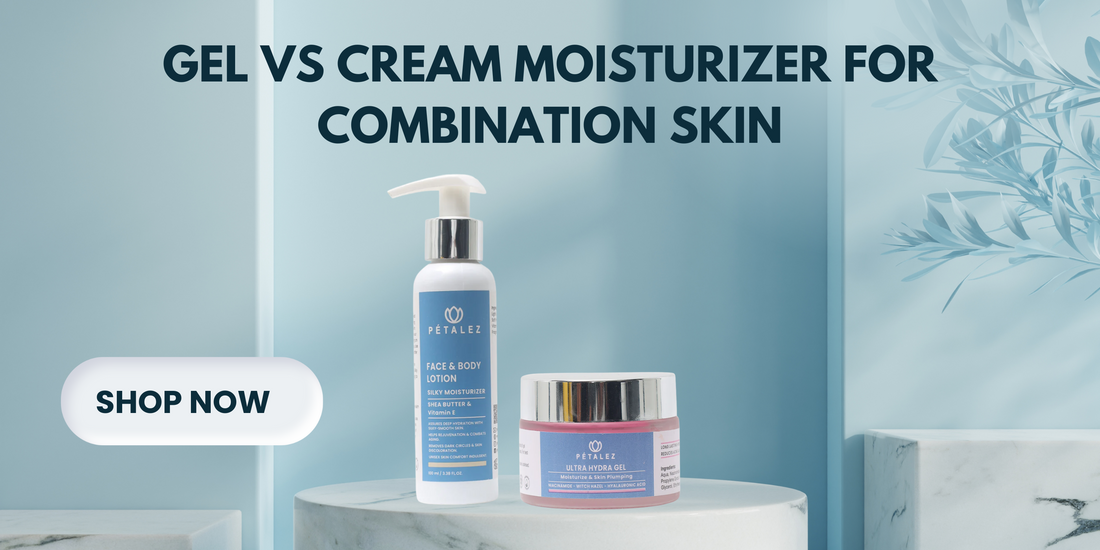
Gel vs Cream Moisturizer for Combination Skin
Share
Choosing a moisturizer for combination skin can feel tricky. Your face has oily zones like the T-zone and dry spots on your cheeks. Finding the right product means balancing these different needs. A good moisturizer keeps your skin smooth, prevents breakouts, and stops from feeling too tight or greasy. Today, we compare gel versus cream moisturizers to help you pick the best fit for your skin's unique needs.
Characteristics and Challenges
Combination skin is a common skin type. It features an oily T-zone—forehead, nose, and chin—plus drier cheeks and sometimes dry patches around the jawline. These conflicting needs make skincare more complicated. You want to hydrate dry patches but not make oily zones worse. Finding the right moisturizer is key for a balanced look.
Why Moisturizer Choice Matters
Using the wrong moisturizer can cause problems. Heavy creams may clog pores and cause breakouts in oily areas. On the other hand, lightweight gels might not hydrate dry spots enough. The goal is to boost moisture without making oily areas shiny or clogged. Proper hydration helps prevent flaky patches and reduces the risk of pimples or irritation.
What Are Gel Moisturizers?
Gel moisturizers are water-based products. Think of them as a cool splash for your face. They usually contain ingredients like hyaluronic acid, aloe vera, and glycerin. These stretch water deep into your skin and keep it feeling fresh.
Benefits of Gel Moisturizers for Combination Skin
Gels are lightweight and feel almost watery. They're great if you dislike heaviness or greasiness. They get absorbed quickly, leaving no sticky residue. Plus, their cooling effect helps calm inflamed skin. If you suffer from oiliness or acne, gels can control shine without drying out your skin.
Drawbacks to Consider
Gels might not provide enough moisture for very dry areas. If your dry patches are severe, gels may not be sufficient alone. Also, some gels lack rich oils or fats needed for deep hydration, so they might not work well in colder weather.
What Are Cream Moisturizers?
Cream moisturizers contain oils, butters, and humectants. They’re thicker, richer products designed to provide deep hydration. Think of them as a nourishing blanket for your face.
Benefits of Cream Moisturizers for Combination Skin
Creams can be great for dry patches, providing long-lasting moisture. They help repair the skin barrier and boost nourishment. When used right, they protect your skin from harsh weather and prevent dullness.
Drawbacks to Keep in Mind
Heavy creams can feel greasy on oily zones, leading to blackheads or breakouts. If you apply too much or don’t choose the right one, it can clog pores. So, they need careful selection based on your skin’s zones.
Comparing Gel and Cream Moisturizers for Combination Skin
Texture and Consistency
Gels are smooth and watery, while creams feel thick and velvety. Gels absorb fast, perfect for quick hydration. Creams need more time to soak in, but give you rich nourishment. Your choice depends on how your skin feels each day.
Hydration and Oil Control
Gels excel at controlling oil and shine, especially in warm weather or humid days. They keep the skin feeling light. Creams deliver moisture to dry patches without overly increasing oiliness if used sparingly. Combining both might be necessary for the best results.
Suitability for Different Climates and Seasons
In summer, gels work well because they cool the skin and prevent excessive oil. During winter, creams can provide needed extra moisture for dry areas. Adjust your moisturizer with the seasons to keep skin balanced.
Ingredient Preferences
Gels often feature hydrating ingredients like hyaluronic acid and aloe vera. These pull water into the skin gently. Creams include ingredients like shea butter, oils, and ceramides to lock in moisture. Choosing the right ingredients depends on your specific needs.
Cost and Accessibility
Both types come in a range of prices. Popular gels include those from brands like Neutrogena and Clinique, which are easy to find. Good creams are available from brands like Cetaphil, Eucerin, and more high-end options. Budget and preference will influence your choice.
Expert Recommendations and Real-World Examples
Dermatologist Advice
Skin experts suggest that if your oily zones dominate, gel moisturizers are a smart pick. For dry patches or seasonal dryness, creams work better. The key is layering—using a gel first, then a light cream if needed.
Actionable Tips for Choosing the Right Moisturizer
- Perform a patch test before trying a new product to avoid reactions.
- Apply lightweight gels first, then layer creams on extra dry areas.
- Adjust your moisturizer based on season or skin condition.
- Incorporate SPF during the day to protect your skin.
Conclusion
Choosing between gel and cream moisturizers depends on your skin's specific zones and the climate. Gels are perfect for oily zones and hot weather, while creams help with dry patches and chilly days. Sometimes, a combination of both works best. The trick is listening to your skin and adjusting your routine accordingly. Remember, the right moisturizer keeps your skin healthy, balanced, and glowing—so pick what suits your needs and make it part of your daily skincare ritual.
FAQs(Frequently asked questions)
Is gel or cream moisturizer better for combination skin?
Gel is ideal for oily zones, while cream works well on dry patches. Many people use both for balanced hydration.
Can I use both gel and cream moisturizers?
Yes. Apply gel on oily areas and cream on dry spots, especially during colder months or at night.
Do gel moisturizers clog pores?
Generally, no. Gel moisturizers are water-based and lightweight, making them suitable for acne-prone or oily areas.
Are cream moisturizers too heavy for combination skin?
Some can be, especially on oily zones. Choose non-comedogenic creams and apply sparingly to dry areas only.
Should I switch moisturizers with the seasons?
Yes. Use gels in humid weather and creams in drier, colder conditions to keep your skin balanced year-round.


